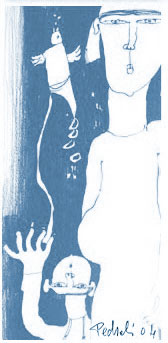Isolated ovine primordial follicles cryopreserved in different concentrations of ethylene glycol
| Isolated ovine primordial follicles cryopreserved in different concentrations of ethylene glycol Ch. A. Amorim, D. Rondina,A.P. Ribeiro Rodrigues, S. H. Furtado Costa , P. B. Dias Gongalves, J. R. de Figueiredo, A. Giorgetti Theriogenology 60 (2003) 735-742 |
|
Cryopreservation
of primordial follicles represents an opportunity to preserve
female gametes, and consequently to protect the reproductive capacity
of humans and animals, as well as to safeguard genetic material
from endangered animal species or rare breeds. The aim of this
work was to assess the toxicity of different concentrations of
ethylene glycol (EG) to primordial follicles, and verify the viability
of these follicles after the freezing-thawing procedure. Primordial
follicles were isolated from ovine ovaries and exposed to different
EG concentrations to evaluate the cryoprotectant (CPA) toxicity
before and after cryopreservation. After isolation of primordial
follicle (control), the number (mean ± S.E.M.) of viable
primordial follicles/ml was 3764 ± 795.21. The number of
viable follicles in the toxicity test using EG at 0, 0.5, 1.0,
1.5, 2.0, and 2.5 M was 1096 ± 447.9, 960 ± 446.67,
948 ± 366.14, 832 ± 313.59, 856 + 280.67, and 700
± 255.02, respectively. The number of viable follicles
at concentrations of 2.5 M was less than for controls. After cryopreservation,
the numbers decreased to 0 ± 0, 148 ± 85.46, 764
± 246.69, 824 + 291.9, 844 ± 296.27, and 588 ±
200.65, respectively for 0, 0.5,1.0, 1.5,2.0, and 2.5 M EG. The
number of viable follicles at 0, 0.5, and 2.5 M was less than
for controls. In conclusion after the freezing and thawing procedure,
concentrations of 1.0, 1.5, and 2.0 M EG can be successfully used
for the cryopreservation of isolated follicles in sheep. |

